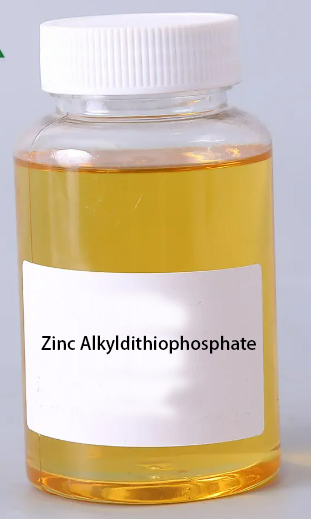Zinc Dialkyldithiophosphate
Analysis of ZDDPs
Zinc dialkyldithiophosphates are important antiwear compounds in machine lubricants. These coordination compounds have zinc attached to the dialkyldithiophosphoric acid anion. ZDDPs are added to engine lubricants to decrease wear and assure dependable operation due to their thermal and hydrolytic stability.
Modern industry uses oil-soluble ZDDPs in marine, aeronautical, and industrial lubricating lubricants. Thermal stability, anti-wear prevention, and cost-effective performance are offered by these lubricating oil additives. The slightly-to-moderate water solubility makes them appropriate for oil-based compositions.
Zinc dialkyldithiophosphate is made by reacting phosphorus pentasulfide with an aliphatic monohydric alcohol and zinc. The chemical is either a straw-yellow to green solid or a sweet, alcohol-like liquid, depending on its composition. Zinc dialkyldithiophosphate is a class of uncharged compounds made of zinc, phosphorus, and traces of sulfur.
Lubricating oil additives with ZDDPs are wear-resistant, anti-rotten, antioxidation, and corrosion inhibitors. Their oil-soluble nature makes them easy to mix with detergent-dispersants and acid neutralizers in engine oils. ZDDPs have become essential to lubrication strategies in many sectors, improving equipment and engine performance and lifetime. Zinc dialkyldithiophosphate reduces wear and improves operating efficiency in marine, aeronautical, and industrial gear.
Health Effects
When zinc dialkyldithiophosphate is heated, it can generate mist or vapors that may irritate the mucous membranes and upper respiratory tract, leading to symptoms like headache, dizziness, and drowsiness. Prolonged exposure can even result in lipoid pneumonia, a condition with serious respiratory symptoms. Direct contact with zinc dialkyldithiophosphate can cause skin irritation, resulting in redness, itching, and swelling. It may also lead to conditions like oil folliculitis and oil acne due to chemical irritation and clogging of hair follicles.
Use of oil-based products containing ZDDP can lead to eye irritation, with symptoms such as redness, tearing, and possible blistering. Ingesting ZDDP can cause gastrointestinal distress, including a burning sensation in the mouth, nausea, vomiting, and diarrhea. If vomiting occurs, aspiration of mineral oil into the lungs can lead to “oil mist pneumonitis,” which is potentially dangerous.
Continued exposure to ZDDP mist or vapors may cause symptoms such as nausea, vomiting, coughing, and difficulty breathing.
Long-term contact with oils may lead to the formation of fibrotic nodules, lipid pneumonia, and lipid granuloma in the lungs. While no specific chronic skin hazards have been reported for ZDDP as a whole, prolonged exposure may still cause mild irritation.
Additionally, repeated and prolonged contact with mineral oils may lead to defatting of the skin, potentially resulting in dermatitis. Similarly, there are no reported chronic eye hazards for ZDDP; however, long-term effects are expected to be similar to acute eye exposure, and excessive exposure may impair vision. Moreover, the effects of chronic ingestion are expected to be similar to those listed for acute ingestion, potentially causing liver damage.
Zinc Dialkyldithiophosphates Application
Zinc Dialkyldithiophosphate (ZDDP) is a lubricating oil additive renowned for its exceptional thermal and hydrolytic stability. Commonly used alongside detergent, dispersant, and acid neutralizing additives in engine oils, this additive provides essential benefits such as oxidation, copper-lead bearing corrosion control, and wear prevention in diesel and gasoline engines. It proves particularly effective under the demanding temperature and load conditions experienced in highly supercharged diesel engines.
ZnDDPs are widely used as anti-wear additives in lubricants, with major applications in greases, hydraulic oils, and motor oils. Additionally, ZnDDPs can serve as corrosion inhibitors and antioxidants.
To analyze ZnDDPs in automotive lubricants, a study employed GC/MS with solid-phase extraction (SPE) pretreatment. The SPE method using a mixed absorbent containing 1.0% active carbon in silica gel base demonstrated excellent results in recovery and reproducibility, making it an effective pretreatment method. The developed method allowed qualitative and quantitative analyses of ZnDDP in various real automotive lubricant samples with high accuracy and reproducibility.
The presence of ZDDPs in lubricants plays a crucial role in controlling oxidation and corrosion, ensuring engines operate smoothly and efficiently. Its antioxidant properties extend the life of engine oil by preventing breakdown caused by sludge and soot deposits on engine components. Furthermore, ZDDPs protect metal surfaces by forming chemical films that guard against corrosion.
Physical and Chemical Properties
In its natural state, ZDDP exists as a yellow liquid with a distinctive odor, but the exact odor threshold has not been established. When dissolved at 2% in TBN-solvent, ZDDP exhibits a pH range of approximately 5 to 6.5. However, the boiling and melting/freezing points of ZDDP have not been specified.
At a temperature of 104 °F (40 °C), ZDDP has a kinematic viscosity of around 150 cm2/s. It is important to note that ZDDP is insoluble in water; however, it does show solubility in mineral oils and synthetic base oils.
The specific gravity of ZDDP varies, with a range of 1.12 to 1.26 for the liquid form and 1.6 for the solid form at 68 °F (20 °C). ZDDP does not contain any Volatile Organic Compounds (VOCs), which is significant from an environmental perspective.
Regarding its chemical formula, specific data for ZDDP is not available. The flash point of ZDDP is approximately 360°F, but information on the Lower Explosive Limit (LEL), Upper Explosive Limit (UEL), and Autoignition Temperature remains unspecified.
Zinc Dialkyldithiophosphate Hazard Information
Excessive exposure to ZDDP can lead to irritation of the eyes, skin, or respiratory system, with the eyes being particularly susceptible to adverse effects. Inhalation of ZDDP dust may cause respiratory discomfort, and ingestion can result in irritation of the mouth and stomach. Direct contact with the eyes can lead to moderately severe irritation, while contact with the skin may cause mild irritation.
From an environmental perspective, ZDDP is considered toxic to aquatic organisms and may cause long-term adverse effects in aquatic environments. ZDDP does not undergo rapid reactions with air or water. However, during combustion, irritating oxides of sulfur and phosphorus may form. Under specific conditions, ZDDP can react with strong reducing agents to produce highly toxic and flammable phosphine gas. Partial oxidation by oxidizing agents may also release toxic phosphorus oxides.
ZDDP falls into the category of esters, sulfate esters, phosphate esters, thiophosphate esters, and borate esters, as well as non-redox-active inorganic compounds. It is harmful if inhaled or ingested, causing respiratory tract irritation and potential nausea or dizziness upon inhalation. Skin and eye irritation may occur upon direct contact.
In case of fires involving ZDDP, caution is needed as toxic gases and fumes may be emitted during burning or thermal decomposition. To minimize the risk of rupture, cold water spray can be used to cool fire-exposed containers. For firefighting purposes, water as fog or mist is recommended, while solid streams may spread the fire.
ZDDP in the Engine
Zinc dialkyldithiophosphate plays a vital role in engine protection and performance, making it the most commonly used zinc-based additive in the automotive industry. Its primary function is to act as an anti-wear agent, preventing premature engine wear by forming a protective film on metal surfaces. Additionally, ZDDP provides essential corrosion and oxidation protection to ensure the engine’s longevity and efficiency.
ZDDP, particularly in the form of zinc dialkyldithiophosphate is especially beneficial for vehicles equipped with flat-tappet camshafts, a common feature in classic cars, hot rods, and older muscle cars. These engines rely on the zinc additive to maintain proper lubrication and prevent wear on the camshaft and other critical components.
As engine oil is the lifeblood of an engine, it serves multiple functions beyond lubrication. One crucial role is heat transfer, as oil is in direct contact with the hottest components within the engine. Temperatures of main, rod, and cam bearing journals can reach as high as 400 degrees during normal operation. Conventional engine oil can handle temperatures up to around 260 degrees (synthetic oil can withstand up to 300 degrees). However, beyond 300 degrees, the oil starts to break down, losing its lubricating properties and becoming ineffective in protecting the engine.
To ensure proper engine protection and prevent oil breakdown, maintaining appropriate levels of zinc in the engine oil is crucial. For performance cars, especially those with higher operating temperatures, using a zinc oil additive allows engine owners to continue using their preferred engine oil while ensuring the necessary level of zinc for effective engine protection.
Alternate Chemical Names
Zinc dialkyldithiophosphate, a compound with various industrial applications, goes by several alternate chemical names. These names include Zinc Dialkyldithiophosphate, Zinc Dihexyldithiophosphate, Zinc Dihexylphosphorodithioat, Zinc O,O-Di-N-butylphosphorodithioate. To simplify its nomenclature, it is commonly referred to using abbreviations such as ZDDP, ZnDTP, and ZDP.
The molecular structure of zinc dialkyldithiophosphate comprises a monomeric unit, and it plays a crucial role in providing excellent anti-wear properties and enhancing the performance of lubricating oils, greases, hydraulic fluids, and motor oils. Its unique chemical composition allows it to form protective films on metal surfaces, preventing friction and wear, and contributing to the overall efficiency and longevity of machinery and engines in a wide range of industries.
I hope this product has raw material products that meet your needs in terms of performance, application, and usage.We will provide standard export packaging to meet the needs of long-distance transportation.At the same time, we will also provide a safety transportation appraisal certificate, whether you require the export to be carried out by sea or railway.
Zinc dialkyldithiophosphate Supplier & manufacturer, factory in China.


